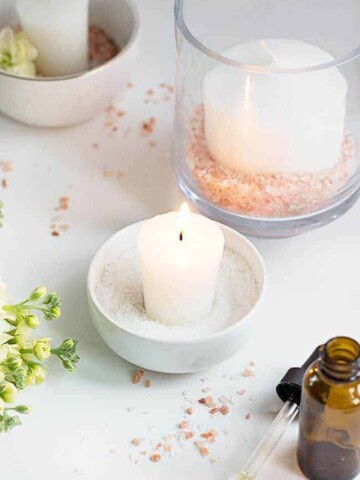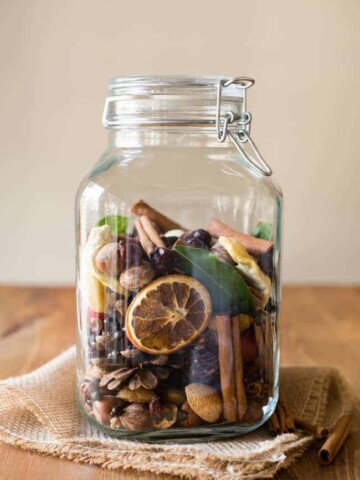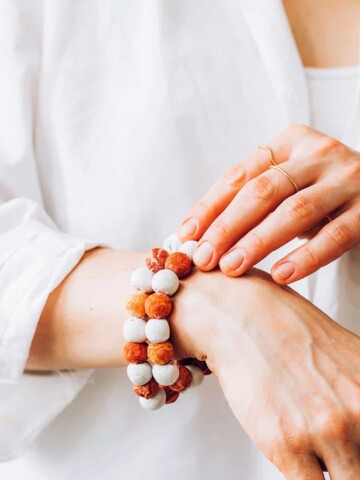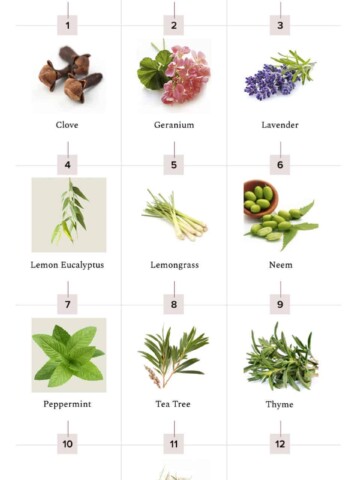Citrus oils are by far some of my favorite essential oils. I am naturally drawn to their bright aromas, and I always find comfort in them—especially bergamot. This lovely oily has many skin benefits so I'm sharing some unique ways to incorporate bergamot into your homemade skincare recipes.
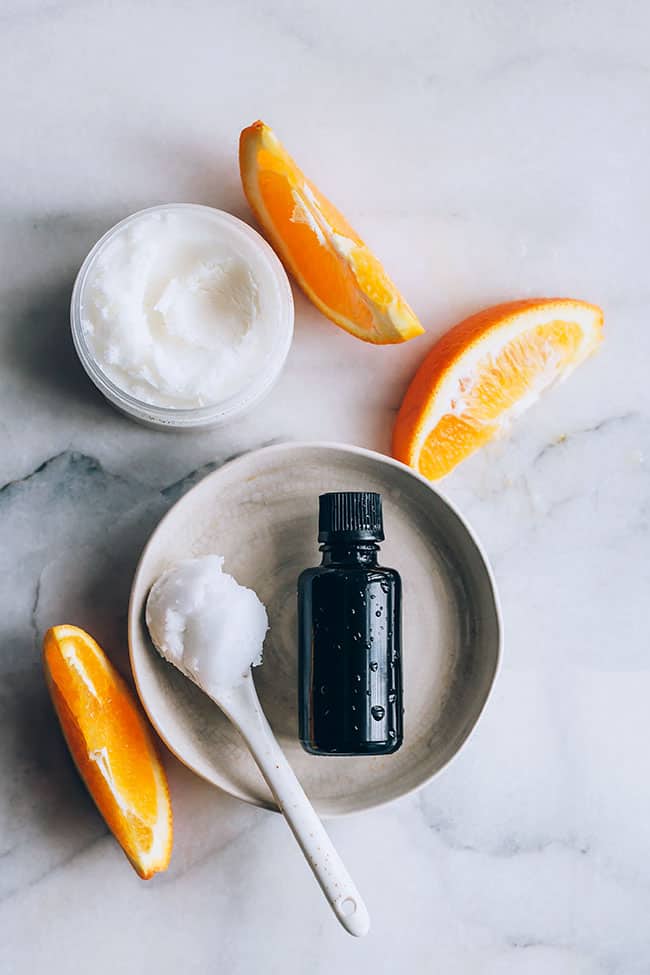
I enjoy the distinct fragrance of bergamot that is neither as sharp as lemon nor as sweet as orange but somewhere in between. It is definitely unique, and I absolutely love it!
As an aromatherapist, I almost always add it to stress-relieving diffuser blends and frequently in my perfumes. I created these bergamot skin recipes to get you started, but feel free to get creative and come up with your own combinations to include this amazing essential oil in your daily routine.
Jump to:
- Bergamot Essential Oil Recipes for Skin + Hair
- 1. Acne Gel Spot Treatment
- 2. Oily Skin + Hair Cleanser
- 3. Pore Refining Bergamot Toner
- 4. Bergamot Dry Skin Night Cream
- 5. Stress-Relievieving Body Scrub
- 6. Bergamot Skin Lightening Face Mask
- 7. Bergamot Chill Out Perfume
- Using Bergamot Safely
- How To Apply Bergamot Topically
- References
Bergamot Essential Oil Recipes for Skin + Hair
There are so many ways that you can use essential oils in your skincare products, and the same is true for bergamot. Derived from the peel of the bergamot fruit, this aromatic oil is a delightful addition to your skincare regimen.
1. Acne Gel Spot Treatment

Not only does bergamot contain antibacterial properties [source], but it has pain-relieving properties as well [source] so it can work nicely as an option for acne, wounds, sores, bug bites, and more.
If you struggle with painful cystic acne (I know I’m not the only one) or just acne in general, then this is the recipe for you. You can either make a gel using organic aloe vera gel or a facial oil with a skin-nourishing carrier oil—like rosehip or jojoba.
Ingredients
- 1 oz organic aloe vera gel or rosehip oil
- 3 drops bergamot essential oil
Instructions
- Mix well and store in a dark-colored flip-top container.
Feel free to use this recipe as a spot treatment or as a daily part of your skincare routine. You can even add in other skin-supporting essential oils—like frankincense or helichrysum!
2. Oily Skin + Hair Cleanser
One of the simplest and most effective ways you can use bergamot is as a cleanser for your skin and hair. It can be especially beneficial if you’re prone to oily skin or acne, as its astringent properties also help to tighten and tone the skin.
What’s more, the antibacterial properties in bergamot can help eliminate bacteria [source] that may be contributing to inflammation and ensure that your skin, scalp, and hair are really getting clean.
Ingredients
- 2 oz of facial cleanser or shampoo
- 6–7 drops of bergamot essential oil
Instructions
- Mix well and store in a dark-colored bottle.
3. Pore Refining Bergamot Toner
Bergamot can help regulate the skin's natural oils, making it beneficial for those with oily skin to help manage acne breakouts. This witch hazel toner is a wonder at controlling oil production and refining your pores.
Ingredients
- ¼ cup witch hazel
- ¼ distilled water or rose water
- 3-5 drops bergamot essential oil
- 1 tablespoon aloe vera gel
Instructions
Mix ingredients and pour into a clean bottle. Use a cotton ball to apply to the face after cleansing.
4. Bergamot Dry Skin Night Cream

The skin-healing properties of bergamot oil can promote the healing of scars and other marks on the skin.
Ingredients
- 2 tablespoon mango butter
- 1 tablespoon argan oil
- ½ teaspoon vitamin E oil
- 5 drops bergamot essential oil
Instructions
- Melt mango butter over low heat, then blend in argan oil and vitamin E oil.
- Once the mixture cools slightly, stir in 5 drops of bergamot essential oil.
- Store in a jar and apply nightly to help nourish and rejuvenate the skin.
5. Stress-Relievieving Body Scrub
Not only does it smell fantastic, but bergamot also a great stress-relieving essential oil (most citrus oils are) [source]. It helps to promote a calm yet uplifting environment.
In fact, when I’m creating blends for stress and anxiety, I almost always include bergamot in my formulations, even in body scrubs.
Not only can scrubs stimulate circulation and lymph flow and exfoliate the skin for a fresh, youthful look, but they can be quite therapeutic in numerous ways based on the ingredients used.
When you use bergamot in your scrubs, you get the acne-fighting action and stress-relieving benefits as well. A win-win!
Ingredients
- ½ cup grapeseed, sweet almond, olive, coconut, or jojoba oil (or other skin-nourishing oil of your choice)
- 1 cup sugar
- 10–15 drops bergamot essential oil
Instructions
- Mix bergamot essential oil and the carrier oil and then combine with the sugar.
- Mix well and store in a mason jar.
6. Bergamot Skin Lightening Face Mask
This simple honey mask can help fight acne and brighten the skin. Honey and bergamot help fight acne-causing bacteria, and adding a pinch of turmeric helps in evening out the skin tone and reduce the appearance of pigmentation.
Ingredients
- 1 tablespoon raw honey
- 3 drops bergamot essential oil
- Small pinch of turmeric powder
Instructions
- Combine honey, bergamot essential oil, and turmeric powder and stir to combine.
- Apply the mixture to your face and leave it on for 15-20 minutes before rinsing off with warm water.
7. Bergamot Chill Out Perfume
The aroma of bergamot is frequently used in personal fragrances like perfumes and colognes, and it’s even a key ingredient in Earl Grey tea! Creating a simple roll-on perfume is a great way to enjoy its fresh and uplifting scent throughout the day.
You can add other essential oils to create a unique blend. For instance, lavender pairs beautifully with bergamot for a relaxing scent, or you might add a bit of sandalwood for a richer, woodsy undertone.
Ingredients
- 10 drops bergamot essential oil
- 5 drops lavender essential oil
- Jojoba oil or fractionated coconut oil
- Vitamin E oil (optional)
- 10 ml glass roll-on bottle
Instructions
- Add essential oils to the roll-on bottle. If using, add a few drops of vitamin E oil. This step is optional but helps to extend the shelf life of your perfume and benefits your skin.
- Fill the rest of the bottle with your chosen carrier oil. Leave a small space at the top to ensure the roll-on applicator can be inserted without overflowing.
- Carefully insert the roll-on applicator and screw on the cap. Shake the bottle gently to mix all the oils.
- Roll onto pulse points like your wrists, neck, and behind the ears. These spots are where the body is warmer, helping to diffuse the scent throughout the day.
Using Bergamot Safely
I do want to mention that bergamot is a phototoxic essential oil. Because of this, it can increase your skin's sensitivity to sunlight, potentially leading to burns or rashes.
However, if you properly dilute and follow the recommended uses (and always wear SPF), you can greatly reduce the risk.
How To Apply Bergamot Topically
Use BF-Free Bergamot: Bergatene-free bergamot oil means that the oil has been made without the natural compound that causes photosensitivity. It retains many of the aromatic and therapeutic properties of traditional bergamot oil but without the risk of causing reactions in sunlight.
Always dilute: Regular bergamot EO should always be used in a diluted form and not applied directly to the skin in its concentrated form. To avoid phototoxicity, don’t use bergamot in dilutions higher than 0.4%.
Caution for sensitive skin: Don’t use bergamot on your skin if you have sensitive skin. Do a patch test on a very small area first to test for skin sensitivities.
Wear sunscreen: Avoid sunlight exposure for 12 hours after using regular bergamot EO on the skin, especially with higher dilutions. Always use sunscreen if you're using bergamot oil on your skin and planning to go outdoors.
References
References
- Watanabe E, et al. Effects of bergamot ( Citrus bergamia (Risso) Wright & Arn.) essential oil aromatherapy on mood states, parasympathetic nervous system activity, and salivary cortisol levels in 41 healthy females. Forsch Komplementmed. 2015.
- Perna S, et al. Efficacy of bergamot: from anti‐inflammatory and anti‐oxidative mechanisms to clinical applications as preventive agent for cardiovascular morbidity, skin diseases, and mood alterations. Food Sci Nutr. 2019.
- Cirmi S, et al. Anti-infective potential of Citrus bergamia Risso et Poiteau (bergamot) derivatives: a systematic review. Phytother Res. 2016.
- Scuteri D, et al. Neuropharmacological properties of the essential oil of bergamot for the clinical management of pain-related BPSDs. Curr Med Chem. 2019.
This article was medically reviewed by Dr. Gina Jansheski, a licensed, board-certified pediatrician with more than 20 years of practice experience. Learn more about Hello Glow’s medical reviewers here. As always, this is not personal medical advice, and we recommend that you talk with your doctor.
64
